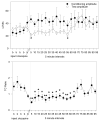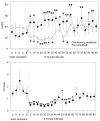An initial animal proof-of-concept study for central administration of clozapine to schizophrenia patients
- PMID: 18178385
- PMCID: PMC2288754
- DOI: 10.1016/j.schres.2007.10.012
An initial animal proof-of-concept study for central administration of clozapine to schizophrenia patients
Abstract
While clozapine is the acknowledged superior pharmacotherapeutic for the treatment of schizophrenia, the side effect profile, which includes potentially fatal complications, limits its usefulness. Central administration of clozapine directly into the brain could circumvent many of the side effect issues due to the dramatic reduction in dose and the limitation of the drug primarily to the CNS. The present study demonstrates that clozapine can be formulated as a stable solution at physiological pH, which does not have in vitro neurotoxic effects at concentrations which may be effective at treating symptoms. Acute central administration improved auditory gating deficits in a mouse model of schizophrenia-like deficits. Assessment of behavioral alterations in rats receiving chronic central infusions of clozapine via osmotic minipump was performed with the open field and elevated plus mazes. Neither paradigm revealed any detrimental effects of the infusion. While these data represent only an initial investigation, they none-the-less suggest that central administration of clozapine may be a viable alternate therapeutic approach for schizophrenia patients which may be effective in symptom reduction without causing behavioral or neurotoxic effects.
Figures






Similar articles
-
TC-5619: an alpha7 neuronal nicotinic receptor-selective agonist that demonstrates efficacy in animal models of the positive and negative symptoms and cognitive dysfunction of schizophrenia.Biochem Pharmacol. 2009 Oct 1;78(7):803-12. doi: 10.1016/j.bcp.2009.05.030. Epub 2009 May 29. Biochem Pharmacol. 2009. PMID: 19482012 Free PMC article.
-
Chronic low dose risperidone and clozapine alleviate positive but not negative symptoms in the rat neonatal ventral hippocampal lesion model of schizophrenia.Psychopharmacology (Berl). 2004 Nov;176(3-4):312-9. doi: 10.1007/s00213-004-1897-4. Epub 2004 Jun 4. Psychopharmacology (Berl). 2004. PMID: 15179541
-
Acute administration of Δ⁹ tetrahydrocannabinol does not prevent enhancement of sensory gating by clozapine in DBA/2 mice.Pharmacol Biochem Behav. 2014 Mar;118:22-9. doi: 10.1016/j.pbb.2014.01.001. Epub 2014 Jan 10. Pharmacol Biochem Behav. 2014. PMID: 24418217 Free PMC article.
-
Management of treatment resistant schizophrenia unresponsive to clozapine.Br J Psychiatry Suppl. 1996 Dec;(31):31-40. Br J Psychiatry Suppl. 1996. PMID: 8968653 Review. No abstract available.
-
Behavioral pharmacology of olanzapine: a novel antipsychotic drug.J Clin Psychiatry. 1997;58 Suppl 10:37-44. J Clin Psychiatry. 1997. PMID: 9265915 Review.
Cited by
-
Translational utility of rodent hippocampal auditory gating in schizophrenia research: a review and evaluation.Transl Psychiatry. 2015 Jun 23;5(6):e587. doi: 10.1038/tp.2015.77. Transl Psychiatry. 2015. PMID: 26101850 Free PMC article. Review.
-
Administration of a 20-Hydroxyeicosatetraenoic Acid Synthesis Inhibitor Improves Outcome in a Rat Model of Pediatric Traumatic Brain Injury.Dev Neurosci. 2019;41(3-4):166-176. doi: 10.1159/000500895. Epub 2019 Sep 25. Dev Neurosci. 2019. PMID: 31553983 Free PMC article.
-
Divergent brainstem opioidergic pathways that coordinate breathing with pain and emotions.Neuron. 2022 Mar 2;110(5):857-873.e9. doi: 10.1016/j.neuron.2021.11.029. Epub 2021 Dec 17. Neuron. 2022. PMID: 34921781 Free PMC article.
References
-
- Alvir JM, Lieberman JA, Saffermanm AZ, Schwimmer JL, Schaaf JA. Clozapine-induced agranulocytosis. Incidence and risk factors in the United States. N Engl J Med. 1993;329(3):162–7. - PubMed
-
- Atkin K, Kendall F, Gould D, Freeman H, Liberman J, O'Sullivan D. Neutropenia and agranulocytosis in patients receiving clozapine in the UK and Ireland. Br J Psychiatry. 1996;169(4):483–8. - PubMed
-
- Azorin JM, Spiegel R, Remington G, Vanelle JM, Pere JJ, Giguere M, Bourdeix I. A double-blind comparative study of clozapine and risperidone in the management of severe chronic schizophrenia. Am J Psychiatry. 2001;158(8):1305–13. - PubMed
-
- Ballantyne JC, Carwood CM. Comparative efficacy of epidural, subarachnoid, and intracerebroventricular opioids in patients with pain due to cancer. Cochrane Database Syst Rev. 2005;25(1):CD005178. - PubMed
-
- Brambilla P, Barale F, Caverzasi E, Tognoni T, Barui C. clozapine-treated subjects with treatment-resistant schizophrenia: a systemic review of experimental and observational studies. Int Clin Psychopharmacol. 2002;17(4):189–195. - PubMed
Publication types
MeSH terms
Substances
Grants and funding
LinkOut - more resources
Full Text Sources
Other Literature Sources
Medical

